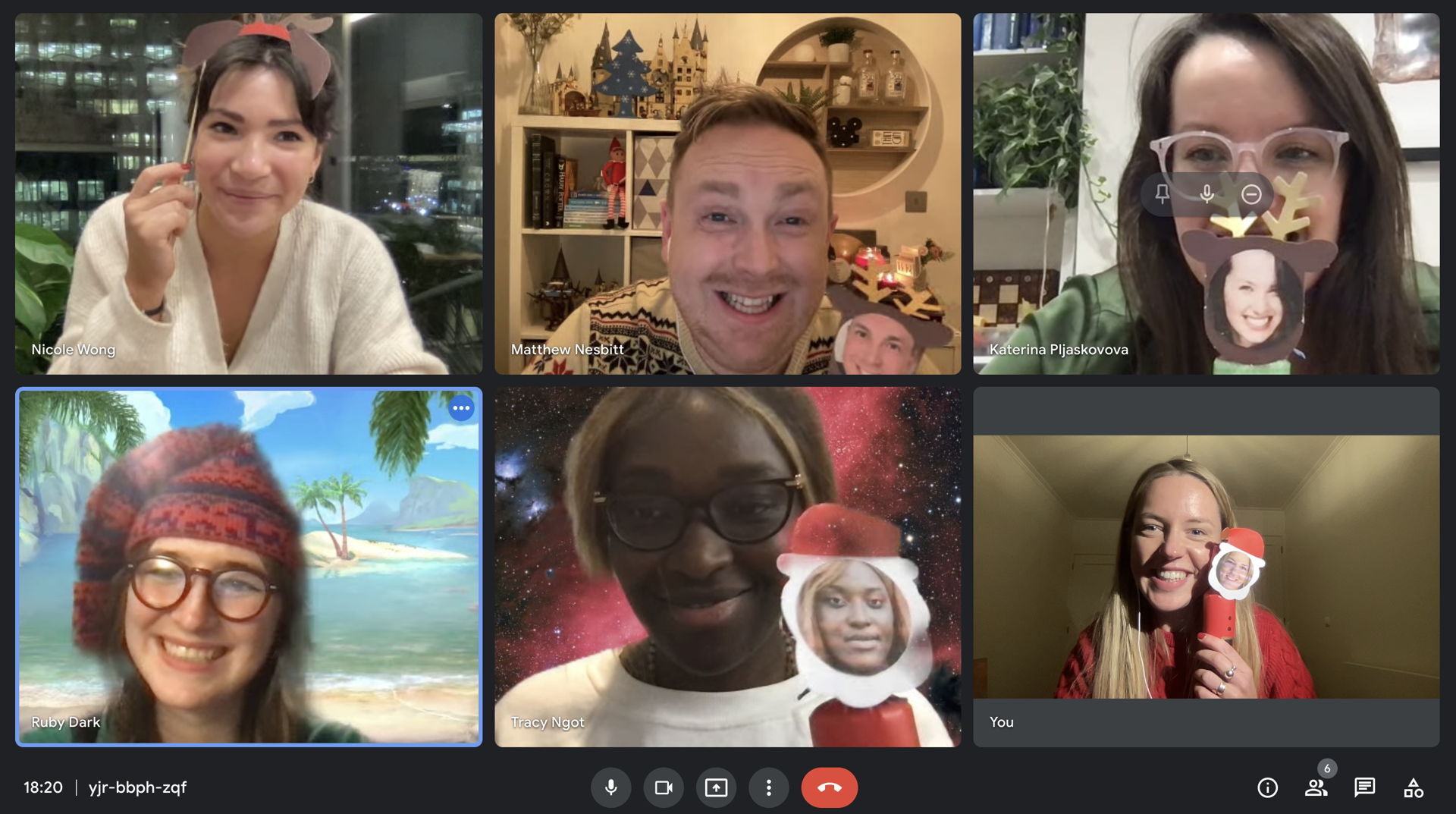How to feel close as a remote team

It’s been almost 2 years since the Covid-19 pandemic turned our everyday lives upside down. Although we all thought we’d be out of the storm by now, some things are here to stay. Remote work is the new normal. To build strong virtual teams, we need to adapt our way of doing things. If it’s not a habit yet, here are some suggestions to make virtual connection part of your everyday routine.
Remote or hybrid work might feel like the new normal for some of us, but it definitely hasn’t replaced the connections we form IRL. It still feels surreal that we’ve only ever seen some of the people we work with every day as a head floating on a screen.
Without spontaneous chats at the coffee machine and popping by each other’s desks to say hello, it’s tougher to feel close to the people we work with. That’s not to say that building virtual connections is impossible. It just requires more deliberate action.
As a fully remote company, at Fair HQ, we know the challenges of growing a remote team whilst maintaining a tight-knit feeling. We’ve got bucket loads of ideas for developing social connections with your remote team. We also know what it takes to maintain a sense of cohesion and inclusion when your colleagues are working in totally different time zones. Here’s how to feel close as a remote team.
Why building connections is so important
Remote work has its positives – no commute, flexible hours, and working from the comfort of your home. But it comes with its cons. Many of us are feeling disconnected from our coworkers. A survey conducted in 2021 by LiveCareer revealed that loneliness is a core challenge for 35% of remote workers.
After the shift to remote work in 2020, Microsoft set out to understand how the pandemic affected work as we know it. Their project, spanning multiple teams, 50+ studies and a survey of over 30,000 participants, revealed that our social circles at work have diminished. We’re spending more time in small groups whilst our connections with people we don’t work with every day have faded.
This trend has knock-on effects on workplace wellbeing. People who connect less with their colleagues feel a lower sense of inclusion and productivity. To break through this isolation, we need to build in deliberate moments to connect with the whole team.
No one wants to feel like a stranger to the people you spend your weekdays with. Even if you mostly see each other through a webcam, you can still cultivate a sense of togetherness. Well-being gets a massive boost when employees feel like a fully-fledged part of the team.
So how can you grow those valuable team connections if you’re hardly ever in the same room? Here are some ideas.
How to feel like a cohesive team
With remote work, many teams have lost a sense of cohesion. Although the solo focus time is a massive bonus of remote work, it also means that our work isn’t as visible to our colleagues.
So how can we make sure we share our knowledge and celebrate each other’s wins when working remotely?
Encourage spontaneous conversations
Knowledge sharing happens naturally in a physical space — you don’t need to plan in advance to sound off ideas in the break room. We’ve lost these spontaneous moments with remote work. Knowing what each other is working on and sharing ideas is a massive part of feeling like a cohesive team. If we feel out of the loop, then we start to feel excluded.
Sure, we message each other regularly throughout the day on Slack, but sometimes it’s way easier to solve a problem when you can talk. To keep spontaneous conversations alive, set the norm for ad hoc and efficient check-ins throughout the day.
Employees should feel able to check in on each other with quick phone calls or huddles whenever a question arises, not only in morning meetings. Team members shouldn’t feel pressured to answer spontaneous requests straight away — this could really break up focus time. Set the expectation to let each other know when you’ll have time to reply to requests and have a quick call to resolve any issue.
At Fair HQ, we like to use Pesto for virtual coworking days. Teammates can ping each other when they have a question and easily hop into different rooms to have a chat. Otherwise, we can keep our mics off and stay online in the same room.
Celebrate wins, big and small
Weekly team celebrations help everyone feel valued, heard and energised. Here’s how we structure our Friday team celebrations at Fair HQ:
- Celebrate each other: Invite your colleagues to praise a member of the team for their work this week — it could be someone who helped unblock you, solve a tough bug or kept everyone focused.
- Show and tell: Ask everyone to share some of their work from the previous week with the team. It could be anything from a new piece of copy, a new webpage design or a satisfying snippet of code. It doesn’t have to be visually beautiful — your expense report spreadsheet deserves a round of applause too!
- Question time: Celebration is a lot about reflecting and learning. Give everyone a chance to ask some questions about each other’s work so they can grow awareness of each other’s expertise. You’ll be surprised at what new ideas spring out of these chats!
Get to know each other as people, not just coworkers
Feeling close as a team isn’t only about sharing work-related knowledge. To feel a sense of togetherness, we also need to get to know each other on a more personal note.
💡 Did you know? Casual social connection does wonders for diversity and inclusion. When people get to know each other outside of structured work activities, they build more empathy towards one another.
It’s easier to understand someone else’s differences when you have a more personal connection with them. Research has shown that when people engage with others from different cultures and backgrounds more frequently, they feel closer to them, display more inclusive behaviour and become less prejudiced.
To build that level of understanding, set up some routines for casual social connection. Here’s a wide variety of activities to help break through the pandemic gloom and get to know each other virtually (tried and tested by the Fair HQ team 👩🔬).
1) Team get-togethers
It’s hard to replace office parties online, but that doesn’t stop us from trying (and having a great time!). When it’s a special occasion — a big birthday, company anniversary or holiday — we dedicate some time to celebrating together. Whether it’s teaching each other our favourite cocktail recipes or doing some Christmas cross-stitching, everyone benefits from turning off their email notifications and trying something different, together.

The Fair HQ team showing off their Christmas crafts in our December virtual team retreat.
2) Photo contests
Create a Slack channel dedicated to your photo contest and run it over a week. Set a theme (such as furry friends, stunning sunsets, or 10 years ago) and get everyone to submit their top snaps. At the end of the deadline, show everyone’s entries in a slideshow and vote on the winner.
3) Random coffee chats
Our team has grown a lot in the last couple of months. We went from chatting to everyone every morning to having to cut back team-wide meetings by necessity. It’s still absolutely crucial that new team members get to know who they’re working with, even if they don’t see their faces on a daily basis.
To keep connections thriving, set up coffee chats between different team members by drawing names from a hat. Or, use a tool to simplify it for you — Donut pairs up random teammates through Slack to have a 15-minute chat.
Regular, casual convos have allowed us to keep that feeling of closeness and also enabled new teammates to get to know everyone without overwhelming intro calls.
4) Scavenger hunts
This is a great way to learn something new about your colleagues. Ever wondered who has the most daring taste in headwear? Or a secret talent for paper-mache? Well, now you can find out!
Make a list of items and give everyone 5 minutes to find them in their homes (or find pictures). It works best if these belongings tell a personal story — something that wouldn’t normally come up in your daily stand-ups. Here’s an example we’ve used before:

5) Questions in a bucket
We love this Miro ice breaker. Take turns to pull out a question and let everyone write their answer on a sticky note. We run this game every month and everyone always has a new story to tell.
6) Online games 👾
We all like to blow off some steam at the end of our week. On Friday afternoons after our weekly celebration, we stick around to play some multiplayer online games. This selection ranges from 5 mins to 1 hour+ so you can take your pick depending on everyone’s availability.
Here are a few of our faves:
- Codenames: Maybe you’ve played this board game before but did you know there’s a free online version? Teams work together to guess the secret words from their Spymaster’s clues. It’s simple to grasp and involves everyone at the same time.
- Skribbl: This online drawing game gets everyone to flex their creative muscles and guess each other’s sketches. It’s totally free and you can squeeze it in the last 10 minutes of your meeting or run an hour-long session, it never gets old.
- Jackbox games: Costing £18 – £22, this is our only non-free suggestion, but it’s so worth it. Jackbox is a multipack of party games with huge variety. Our favourite is Quiplash (think Cards Against Humanity with more room for personal flair). Up to 8 people can play at a time.
- Around’s built-in games: Do you use Around to host your team meetings? If not, give it a try. One of its many amazing features are the 3-minute party games, inspired by retro arcade games. Perfect for a little boost at the end of a long meeting.
Make it last
Team fun doesn’t have to be confined to one day of the week, and certainly not to one day of the year. Try out some of the ideas in this post and see what sticks with your team. Embed your favourites into your weekly routines to set the habit. Watch meaningful connections on your remote team flourish!
Backing it up
Baym, N. &Larson, J. & Martin, R. (2021) What a Year of WFH Has Done to Our Relationships at Work, Harvard Business Review
Campbell, M. and Gavett, G. (2021) What Covid-19 Has Done to Our Well-Being, in 12 Charts, Harvard Business Review
Kirkman, B. L., & Stoverink, A. C. (2021). Building Resilient Virtual Teams. Organizational Dynamics, 50(1)
Lowy, J. (2020) ‘Overcoming Remote Work Challenges’ MIT Sloan Management Review
O’Flaherty, S., Sanders, M. and Whillans, A. (2021). Research: A Little Recognition Can Provide a Big Morale Boost, Harvard Business Review
Onyeador, I. N., Hudson, S. K. T., & Lewis Jr, N. A. (2021). Moving beyond implicit bias training: Policy insights for increasing organizational diversity. Policy Insights from the Behavioral and Brain Sciences, 8(1), 19-26.